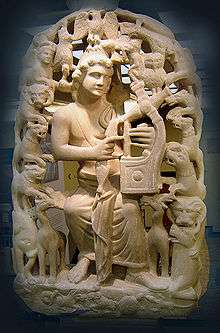Zeibekiko
| Music of Greece | |
|---|---|
 | |
| General topics | |
| Genres | |
| Specific forms | |
| Media and performance | |
| Music awards |
|
| Music charts | |
| Music festivals | |
| Music media |
|
| Nationalistic and patriotic songs | |
| National anthem | "Hymn to Liberty" |
| Regional music | |
| Related areas | Cyprus, Pontus, Constantinople, South Italy |
| Regional styles |
|
Zeibekiko (Greek: Ζεϊμπέκικο) is a Greek folk dance.
Origin and history
It takes its name from the Zeybeks, an irregular militia living in the Aegean Region of the Ottoman Empire from late 17th to early 20th centuries.[1] It was first seen at the end of the 17th century in cities such as Constantinople and Smyrni. Evliya Çelebi mentions in his writings that it was danced in Magnesia and in Aydın at local feasts.[2] Originally a dance for two armed people facing one another, it developed into an improvised dance for a single male.[3]
After the population exchange between Greece and Turkey in 1922, the dance became popular also in mainland Greece, in many songs of Laiko music.
Characteristics
The Zeibekiko usually has a rhythmic pattern of 9/4[4] or else 9/8. It is most commonly broken down as:
or as:
The Zeibeikiko, as an old dance, is strictly for males. Due to the movements of the dancer, it is sometimes known as the "eagle dance".[5] The dance has no set steps, only certain figures and a circular movement. It takes place in an area little surpassing one square metre and mostly consists of improvised movements.[6]
Occasionally dancers perform feats such as standing on a glass of wine or a chair or fireplace, or picking up a table, adding a sense of a little braggadocio and humor.[7]
See also
References
- ↑ Babiniotis, Georgios D. (2002). Lexiko Tis Neas Ellinikis Glossas (2nd ed.). Athens: Kentro Lexikologias. p. 707. ISBN 960-86190-1-7.
- ↑ Πάλλης, Α. (1941). Σελίδες της παλιάς γενιτσάρικης Τουρκίας. Athens: Εκάτη. p. 231.
- ↑ Tyrovola, V. (1994). "The evolutionary process of the dynamics of popular urban culture: The case of Zeibekiko dance". Proceedings of the 17th Symposium of the Study Group of Ethnoarchaeology: 107–113.
- ↑ Kilpatrick, David. "Ethnomusicology", Vol. 6, No. 3, Canadian Issue (Sep., 1972), p. 577.
- ↑ McGinnis, Maura (2004). Greece : a primary source cultural guide (1st ed.). New York: Rosen Pub. Group. ISBN 978-0823939992.
- ↑ Holst, Gail (1994). Road to rembetika : music of a Greek sub-culture : songs of love, sorrow, and hashish (Reprinted with amendments 1994. ed.). Athens: D. Harvey. p. 268. ISBN 978-9607120076.
- ↑ Many authors. Ζεϊμπέκικος. Pandect: The World of Greek Dance (in Greek). Retrieved 19 June 2013.